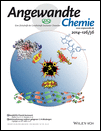Self-Healable Electrically Conducting Wires for Wearable Microelectronics†
This research was supported by the NSFC (21225417), MOST (2011CB932503), STCSM (12nm0503200), the Fok Ying Tong Education Foundation, the Program for Professors of Special Appointment at Shanghai Institutions of Higher Learning, and the Program for Outstanding Young Scholars from the Organization Department of the CPC Central Committee.
Abstract
Electrically conducting wires play a critical role in the advancement of modern electronics and in particular are an important key to the development of next-generation wearable microelectronics. However, the thin conducting wires can easily break during use, and the whole device fails to function as a result. Herein, a new family of high-performance conducting wires that can self-heal after breaking has been developed by wrapping sheets of aligned carbon nanotubes around polymer fibers. The aligned carbon nanotubes offer an effective strategy for the self-healing of the electric conductivity, whereas the polymer fiber recovers its mechanical strength. A self-healable wire-shaped supercapacitor fabricated from a wire electrode of this type maintained a high capacitance after breaking and self-healing.




